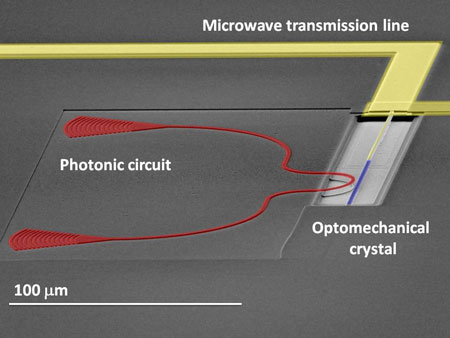Optomechanical Crystals: Merging Light and Sound at the Nanoscale
What are Optomechanical Crystals?
Optomechanical crystals are engineered nanostructures that combine the properties of photonic crystals and phononic crystals to enable strong interactions between light and mechanical vibrations at the nanoscale. These structures consist of periodic arrays of nanoscale elements, such as holes or pillars, etched into a material that can simultaneously confine and guide both optical and mechanical waves.

Key Concepts in Optomechanical Crystals
Optomechanical crystals rely on several key concepts that enable the strong coupling between light and mechanical vibrations:
Photonic Bandgap
The periodic structure of optomechanical crystals creates a photonic bandgap, a range of frequencies at which light cannot propagate through the structure. By carefully designing the geometry and dimensions of the periodic elements, researchers can engineer the photonic bandgap to confine and guide light at specific wavelengths.
Phononic Bandgap
Similarly, the periodic structure also creates a phononic bandgap, a range of frequencies at which mechanical vibrations (phonons) cannot propagate through the structure. By engineering the phononic bandgap, researchers can confine and guide mechanical vibrations at specific frequencies.
Optomechanical Coupling
When the photonic and phononic bandgaps overlap, strong optomechanical coupling can occur. This coupling arises from the interaction between the confined optical and mechanical modes, where the presence of one influences the properties of the other. For example, the mechanical vibration can modulate the optical resonance frequency, while the optical field can exert a force on the mechanical resonator.
Fabrication of Optomechanical Crystals
Optomechanical crystals are typically fabricated using advanced nanofabrication techniques, such as electron beam lithography and reactive ion etching. These techniques allow for the precise control over the geometry and dimensions of the periodic structures at the nanoscale. Common materials used for optomechanical crystals include silicon, silicon nitride, and gallium arsenide, due to their favorable optical and mechanical properties.
Applications of Optomechanical Crystals
Optomechanical crystals have numerous potential applications in various fields, including:
Quantum Information Processing
Optomechanical crystals can be used as quantum interfaces between light and mechanical vibrations, enabling the transfer and manipulation of quantum information. They can serve as quantum transducers, converting quantum states between optical and mechanical domains, which is crucial for developing quantum networks and quantum computers.
Sensing and Metrology
The high sensitivity of optomechanical crystals to external perturbations makes them promising candidates for ultra-sensitive sensing applications. They can be used to detect tiny forces, displacements, or changes in mass, with applications in accelerometers, gyroscopes, and chemical or biological sensors.
Nonlinear Optics
The strong optomechanical coupling in optomechanical crystals can give rise to nonlinear optical effects, such as wavelength conversion, optical amplification, and generation of non-classical light states. These nonlinear effects can be harnessed for applications in quantum optics, optical signal processing, and optical computing.
Challenges and Future Perspectives
Despite the significant progress in the field of optomechanical crystals, several challenges remain. One of the main challenges is the fabrication of high-quality optomechanical crystals with low optical and mechanical losses, which is essential for achieving strong optomechanical coupling and high-performance devices.
Future research in optomechanical crystals will focus on the development of novel designs and materials that can further enhance the optomechanical coupling and reduce losses. The integration of optomechanical crystals with other photonic and electronic components, such as waveguides and superconducting circuits, will also be crucial for realizing practical applications. Additionally, the exploration of new physical phenomena, such as topological optomechanics and non-reciprocal optomechanical interactions, will open up new avenues for fundamental research and innovative applications.
Further Reading
Nature, Optomechanical crystals
Nature Communications, Two-dimensional optomechanical crystal cavity with high quantum cooperativity
Nature Communications, Optomechanical crystal with bound states in the continuum
